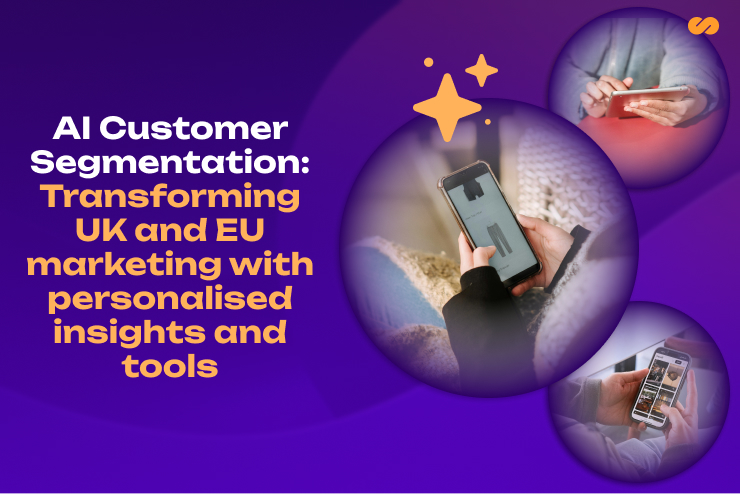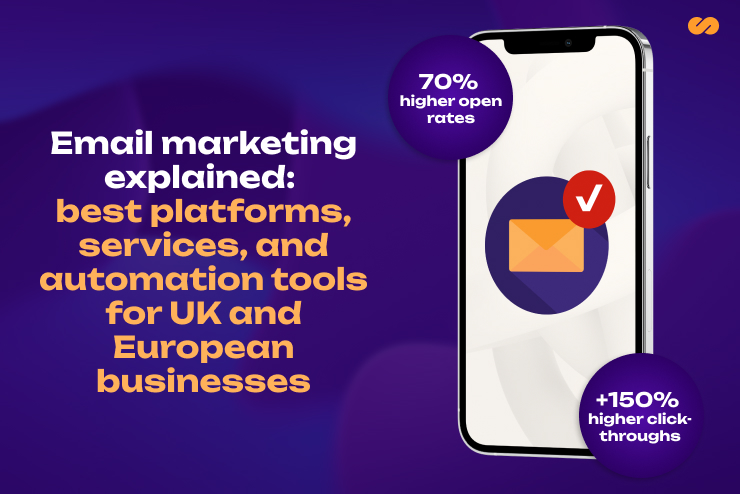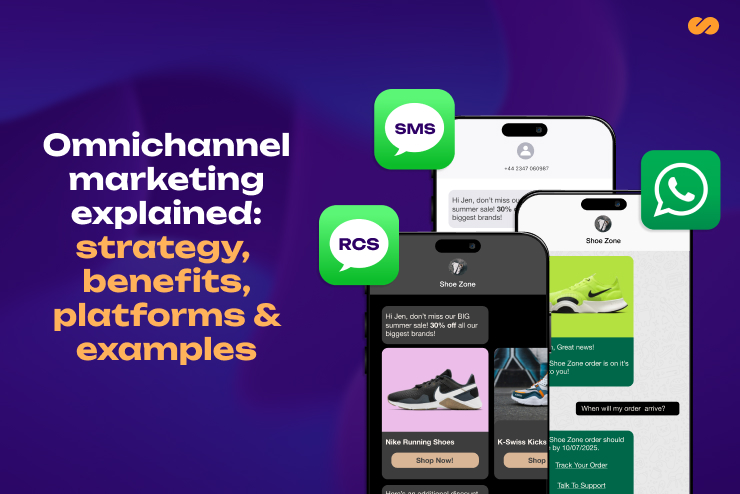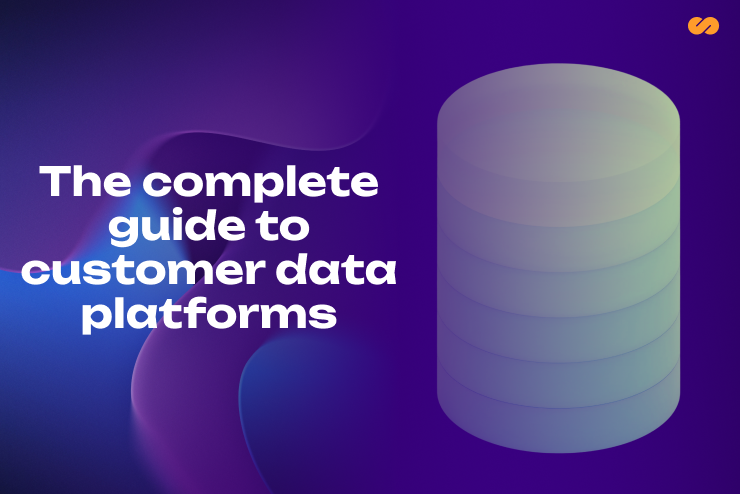AI Customer Segmentation: Transforming UK and EU Marketing with Personalised Insights and Tools
Discover how AI customer segmentation transforms marketing with data-driven precision. Learn how to personalise campaigns, boost targeting accuracy, and explore top AI tools and UK and EU solutions that help eCommerce and online retailers grow through smarter customer insights.

Marketing teams across the UK and Europe are facing a harsh reality: traditional customer segmentation is no longer yielding the desired results. Despite access to more customer data than ever, conversion rates remain low, and the cost of acquiring new customers continues to rise. The issue is not the amount of data but how it is analysed and applied.
For decades, marketers relied on broad demographic categories, assuming that all 25 to 34-year-old professionals or all suburban families share the same purchasing behaviours. This one-size-fits-all approach oversimplifies human behaviour and ignores the complexity of modern consumer patterns.
AI customer segmentation is changing the game. By using artificial intelligence and machine learning, businesses can analyse vast amounts of behavioural data and create precise customer segments that reflect real-world complexity rather than generic demographics. The benefits are clear. Companies using AI-driven segmentation report impressive results: ASOS increased revenue by £77.5 million, Netflix achieved annual savings of $1 billion, and American Express saw engagement rates 2.5 times higher than traditional methods.
The UK market is keeping pace with this global shift. AI adoption in marketing sits at 47% among UK businesses, slightly behind the US at 61%, but growing rapidly. Government initiatives are driving a 15% annual expansion, and London alone has seen a 30% increase in AI venture capital in 2025. UK companies are focused on practical AI deployment, leveraging user behaviour tracking on websites to improve segmentation and customer engagement.
Understanding AI Customer Segmentation Fundamentals
What is AI Customer Segmentation
AI customer segmentation represents the next step in understanding customers, moving beyond traditional demographic, psychographic, and behavioural analysis. Unlike conventional methods that rely on basic demographic data, AI uses machine learning to identify complex patterns in customer behaviour, preferences, and motivations.
The key difference is precision and the removal of assumptions. Traditional segmentation creates broad categories based on shared characteristics, assuming customers within each group behave similarly. AI customer segmentation eliminates these assumptions, analysing data patterns to reveal a more nuanced understanding of individual customer behaviour.
Modern AI segmentation systems combine multiple data types. These include transactional records, behavioural patterns, sentiment analysis from social media, and customer service interactions. This comprehensive approach creates microsegments, highly specific customer groups based on granular behavioural insights rather than generic demographics.
How AI and Customer Segmentation Work Together
The combination of AI and customer segmentation provides new possibilities for marketers. AI systems process large volumes of data from multiple sources simultaneously, including:
- Social media interactions
- Purchase histories
- Email engagement
- Customer service conversations
Machine learning algorithms detect complex patterns that human analysis may miss. For example, AI may identify that customers browsing certain product categories on mobile devices at particular times are significantly more likely to purchase within 72 hours when presented with personalised content.
This dynamic method ensures that customer segments evolve in real time as behaviours change. Unlike traditional static methods that update quarterly, AI-powered segmentation keeps marketing strategies relevant and effective, providing deeper insights into customer preferences and behaviour.
How AI Customer Segmentation Works: The Science Behind Smart Marketing
At the core of AI customer segmentation are advanced machine learning algorithms that analyse customer behaviour, predict patterns, and reveal opportunities that traditional methods cannot detect. These technologies help businesses understand their audience with unprecedented precision, creating actionable insights for marketing and personalisation.
Key AI techniques include:
Predictive models
Linear regression and other predictive algorithms estimate customer lifetime value and purchase probability. This allows businesses to forecast demand and tailor strategies more effectively.
Classification algorithms
These segmented customers into distinct groups based on behaviour, making it easier to deliver targeted messaging and personalised experiences.
Clustering techniques
Clustering groups of similar customers without predefined categories. This often uncovers hidden opportunities, revealing microsegments that traditional methods would overlook.
Natural Language Processing
NLP allows AI to analyse unstructured data such as customer feedback, reviews, social media posts, and support conversations. This uncovers sentiment, emerging trends, and preferences that numeric data alone cannot detect.
Cross-channel integration and identity resolution
AI customer segmentation tools bring together data from multiple touchpoints. By combining email engagement, website interactions, social media activity, and in-store purchases, these tools break down traditional silos.
Identity resolution ensures that data from different sources is linked correctly, creating a single, unified view of each customer.
Real-time adaptability
Modern AI systems process data instantly, allowing segmentation strategies to evolve as customer behaviour changes.
Marketing messages remain relevant, timely, and highly personalised, giving businesses a competitive edge in engagement and customer satisfaction.
How AI Customer Segmentation Improves Targeting and Personalisation
AI-Powered Targeting for Precise Customer Insights
AI customer segmentation transforms customer targeting by analysing hundreds of data points to create highly specific profiles. Rather than relying on broad demographic groups, AI examines behaviours such as:
- Browsing patterns
- Preferred email engagement times
- Social media interactions
- Purchase decision timelines
This allows for “segment of one” marketing, where each customer receives a personalised experience based on their unique behaviour. For example, Customer A may respond best to social proof and testimonials, while Customer B prefers detailed technical specifications. This granular insight drives better engagement and more effective marketing campaigns.
Predictive segmentation takes targeting a step further. By analysing historical data patterns, AI can forecast future customer behaviour, enabling businesses to anticipate needs before customers even recognise them. Netflix uses this approach to analyse viewing habits, predict content preferences, maintain engagement, and reduce churn to just 2.4%, well below industry averages.
Personalisation at Scale with AI Customer Segmentation
AI personalisation works across multiple channels and touchpoints. Machine learning algorithms determine the most effective content, timing, and channel for each customer. For instance, some customers may prefer promotional emails on Tuesday mornings, while others engage more with weekend social media content.
Dynamic content adaptation is another major benefit. AI automatically adjusts website layouts, product recommendations, and promotional offers in real time based on individual behaviour. This creates unique experiences for every visitor without requiring manual input from marketing teams.
Abandoned cart recovery and abandoned basket emails are practical applications of AI personalisation in eCommerce. By identifying when a shopper leaves items in their basket, predicting their likelihood of purchase, and sending timely, highly targeted reminders, AI enables more effective conversion rate optimisation (CRO). For online retailers across the UK and Europe, this translates into higher sales, improved customer engagement, and more efficient marketing performance.
Companies like Phrasee leverage natural language processing to craft email subject lines and content tailored to individual recipients’ preferences, boosting open and click-through rates. Cross-channel personalisation ensures a consistent experience across email, social media, websites, and mobile apps.
Leading AI Customer Segmentation Tools and Platforms
AI customer segmentation tools are transforming how businesses understand and engage their audiences. These platforms combine machine learning, behavioural analysis, and predictive algorithms to create detailed customer profiles. The right tools allow marketers to identify opportunities, deliver personalised messaging, and optimise campaigns across multiple channels.
SaleCycle: Advanced AI and Behavioural Segmentation
SaleCycle is a leading AI customer segmentation tool. Its advanced website visitor identification technology can recognise a significant portion of anonymous website visitors, converting unknown traffic into identifiable customer profiles.
The platform uses behavioural segmentation and predictive algorithms to analyse browsing patterns, preferences, and purchase histories. These insights enable marketers to craft personalised messages and optimise timing, helping businesses engage customers more effectively.
Real-world results:
- Claudie Pierlot achieved substantial revenue growth using SaleCycle integrated with Salesforce Marketing Cloud.
- L’Occitane leveraged AI insights from previously anonymous visitors to enhance their eCommerce strategy.
Enterprise-Level Platforms and Specialised Solutions
Google Analytics and Google Ads integrate AI customer segmentation to refine audience targeting, allowing businesses to create advanced customer segments based on behavioural data and conversion likelihood.
HubSpot offers AI-powered CRM segmentation, with companies reporting increased lead conversion rates through personalised marketing campaigns.
Specialised AI platforms include:
- Peak: Offers comprehensive customer profiling with over 35 AI attributes for precise segmentation.
- Optimove: Focuses on customer loyalty and multichannel engagement through AI-powered segmentation.
- Klaviyo: Combines predictive AI segmentation with scalable email and SMS marketing automation.
- Segment.io: Integrates with hundreds of platforms, including CRM and marketing automation software, providing unified customer views for more accurate segmentation strategies.
The UK AI Customer Segmentation Landscape
The UK has experienced rapid growth in AI businesses, with a 600% increase since 2014. This expansion has created a thriving ecosystem of AI customer segmentation solutions, offering businesses a wide range of tools to personalise marketing strategies, improve targeting, and gain deeper customer insights.
Implementation Strategies and Best Practices for AI Customer Segmentation
Why Implementing AI Customer Segmentation Matters
Successfully deploying AI customer segmentation requires a structured approach, starting with understanding specific business challenges. Companies should identify pain points in current customer analysis, marketing effectiveness, and customer experience delivery. This ensures that AI tools and data sources provide maximum value.
Preparing Your Data for AI
The first critical step is comprehensive data collection and preparation. AI for customer segmentation depends entirely on the quality and completeness of data. Relevant information should be gathered from CRM systems, website analytics, social media platforms, email marketing tools, and customer service interactions.
Data cleaning and preprocessing are essential: AI models only perform as well as the data used to train them. High-quality, well-structured data ensures more accurate and actionable customer segments.
Step-by-Step Implementation Process
- Understanding Business Needs: Conduct a thorough review of current segmentation challenges and marketing objectives. Identify areas where AI could have the greatest impact.
- Choosing Machine Learning Models: Select algorithms based on segmentation goals. Linear regression models are effective for predicting customer lifetime value, while clustering algorithms reveal natural customer groupings.
- Training and Testing Models: Train AI models on historical customer data to detect patterns and refine predictions. Continuous evaluation improves accuracy and performance over time.
- System Integration: Integrate AI tools seamlessly with existing CRM systems, marketing automation platforms, and analytics tools to ensure smooth adoption and real-time insights.
Starting with Pilot Projects
For businesses new to AI customer segmentation, focused pilot projects are ideal. Examples include:
- Segmenting dormant customers for re-engagement campaigns
- Building churn prediction models
- Personalising email campaigns with AI-driven content
These initiatives demonstrate tangible value without requiring large-scale system overhauls.
Real-World Applications and Success Stories of AI Customer Segmentation
How AI Customer Segmentation Drives Results
The fashion and retail sector has seen transformative results from AI customer segmentation. ASOS uses AI and machine learning to segment customers based on browsing behaviour, purchase history, and returns data. These strategies generated £77.5 million in incremental revenue directly attributable to AI-powered customer segmentation.
In entertainment, Netflix sets the benchmark for AI audience segmentation. The platform segments viewers using behavioural and demographic data to power content recommendations. By analysing viewing history, genre preferences, and habits, Netflix delivers tailored content, saving approximately $1 billion annually in customer retention costs.
Generative AI for Hyper-Personalised Marketing
Generative AI is shifting marketing from reactive to predictive, from generic to hyper-personalised, and from static to dynamic. L’Oréal leverages generative AI for real-time customer segmentation in digital campaigns. By analysing customer preferences, skin tone data, and browsing history, L’Oréal’s campaigns achieved a 22% conversion rate and a 26% increase in click-through rates.
Generative AI also automates routine marketing tasks such as content creation, campaign optimisation, and customer communications. Additionally, it enhances marketing analysis by processing unstructured data from reviews and social media to identify trends and market opportunities.
European Market Adoption Patterns
Adoption of AI customer segmentation varies across European markets. In Italy, 81% of shoppers are open to interacting with AI chatbots for customer service, reflecting strong acceptance of AI in customer experiences.
French companies are investing heavily in AI infrastructure, though only 33% of large enterprises have fully adopted AI customer segmentation, indicating significant growth potential.
Spain leads enterprise adoption at 44% among large companies, particularly in banking and finance, where AI improves customer experience and risk management. These differences across European markets present opportunities for businesses to gain a competitive edge by adopting AI early.
Advanced AI Tools for eCommerce Personalisation
Top AI Tools for Personalised eCommerce Experiences
Beyond SaleCycle, several AI customer segmentation tools specialise in eCommerce personalisation:
Optimove: Enhances brand loyalty with AI-powered segmentation and multichannel communication. It integrates data from multiple sources to deliver customised content for distinct customer segments.
Klaviyo: Uses predictive AI segmentation to deliver highly targeted email and SMS campaigns.
Peak: Offers advanced customer profiling with multiple AI attributes, enabling precise personalisation at scale.
These tools help businesses create hyper-personalised experiences tailored to each customer’s behaviour and preferences.
How AI Enhances e-Marketing Strategies
AI improves e-marketing by analysing customer data to forecast behaviour and engagement, enabling marketers to:
- Identify which customers are most likely to make purchases and the optimal time to engage them.
- Automatically personalise website content, email campaigns, and social media advertising in real time.
- Maintain consistent, cross-channel experiences across all touchpoints, ensuring personalised interactions feel seamless and relevant.
With AI customer segmentation and these advanced tools, eCommerce brands can increase engagement, drive conversions, and improve customer loyalty.
Challenges, Solutions, and Expert Guidance in AI Customer Segmentation
Common Challenges When Implementing AI Customer Segmentation
Implementing AI customer segmentation can be daunting, even for experienced teams. The biggest hurdles often include:
- Data quality and integration: Customer data is often spread across multiple, disconnected systems, making it tricky to analyse.
- Choosing the right algorithms: Picking and training machine learning models requires expertise that not all businesses have in-house.
- Resource and capacity constraints: Smaller teams can find model maintenance and ongoing optimisation challenging.
Even so, recognising these challenges early can save time and help ensure a smoother implementation.
How Marketing Agencies Make AI Work
Marketing agencies are leading the way in leveraging AI and customer segmentation to drive results. They do this by:
- Creating precise audience targeting: AI segmentation allows campaigns to reach the right people at the right time, improving conversion rates and advertising ROI.
- Personalising content at scale: Agencies can produce hundreds of tailored messages for different segments without needing additional creative resources.
- Using predictive analytics: AI forecasts campaign performance and customer lifetime value, making it easier to show measurable results to clients.
These practical applications demonstrate that even complex AI tools can deliver real business value when used strategically.
Expert Guidance for Successful Adoption
Professional guidance can accelerate success, particularly in cases involving:
- Large or messy datasets that need careful cleaning
- Uncertainty over which segmentation models to use
- CRM or system integration requirements
- Running multiple experiments simultaneously
By combining structured implementation with expert support, businesses can overcome these obstacles and fully benefit from AI customer segmentation.
The Future of AI Customer Segmentation
How Generative AI Is Shaping Marketing
The marketing industry is on the brink of a major transformation. Gartner predicts that by 2025, one in five marketing tasks will be fully automated, changing the way teams operate. Roles like AI Marketing Specialist are emerging, blending traditional marketing skills with AI expertise.
Generative AI is delivering tangible business benefits far beyond traditional marketing. For example, companies implementing AI customer segmentation report significant revenue growth, from ASOS’s £77.5 million increase to Netflix’s $1 billion annual savings.
Success in an AI-driven landscape depends on strategic preparation: investing in scalable platforms that integrate seamlessly with existing systems and support future growth. Businesses that embrace these tools will be able to anticipate customer needs and stay ahead of market trends.
Conclusion
The shift from traditional demographic segmentation to AI-powered customer intelligence is more than just a technological upgrade. It is a fundamental change in how businesses understand and engage their customers.
Companies that continue relying on broad demographic assumptions risk falling behind competitors using AI audience segmentation to deliver precise, personalised experiences. Treating customers as unique individuals rather than statistical categories is now essential for success.
Platforms like SaleCycle demonstrate the power of AI customer segmentation tools, converting up to 70% of anonymous visitors into meaningful insights. This highlights the importance of professional AI solutions for businesses looking to transform marketing and customer engagement.
The future belongs to organisations that:
- Understand customers at the individual level
- Deliver personalised experiences across all touchpoints
- Use predictive analytics to anticipate changing preferences
The tools and expertise needed for this transformation are already available. Businesses that act now can secure a competitive advantage and create more meaningful, revenue-driving customer relationships.
AI Customer Segmentation FAQs for UK and EU Businesses
What is AI customer segmentation and why does it matter for UK and EU businesses?
AI customer segmentation uses machine learning to group customers by behaviour and value, helping UK and EU businesses deliver personalised marketing that increases engagement and ROI.
How does AI improve customer targeting and personalisation?
AI analyses real-time customer data to predict preferences, enabling brands to send hyper-relevant offers. This boosts conversions, retention, and customer loyalty at scale.
What are the best AI customer segmentation tools for UK and European markets?
Leading tools include SaleCycle, Segment, and enterprise AI platforms offering GDPR-compliant insights tailored to UK and EU retailers and eCommerce merchants.
How can I implement AI customer segmentation in my eCommerce business?
Start with clean data, choose an AI tool that integrates with your CRM, run pilot campaigns, and optimise continuously to enhance customer experience and sales.
What challenges do UK and EU firms face with AI segmentation?
Data privacy, integration, and skill gaps are key hurdles. Solutions include GDPR-aligned platforms, expert partnerships, and phased AI adoption strategies.
How can AI customer segmentation increase online sales?
AI finds your most valuable customers and tailors offers they’re most likely to buy. This data-driven targeting helps UK and EU retailers lift sales and reduce wasted ad spend.
Is AI customer segmentation affordable for small UK businesses?
Yes. Many cloud-based AI tools now offer flexible pricing and easy setup, letting small UK businesses use advanced segmentation without enterprise costs.
How does AI segmentation support GDPR compliance in Europe?
AI tools built for the EU market use privacy-safe data handling, anonymisation, and consent tracking, helping businesses stay compliant while improving marketing accuracy.
Can AI segmentation work with my existing CRM or email platform?
Absolutely. Most AI segmentation tools integrate with CRMs, email systems, and analytics platforms, syncing customer data for smarter, automated campaigns.
What’s the future of AI customer segmentation in UK and EU marketing?
AI is moving toward predictive personalisation, where algorithms anticipate customer needs. UK and EU brands using this tech gain a strong competitive edge.





